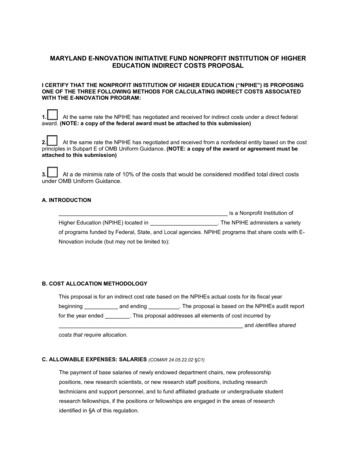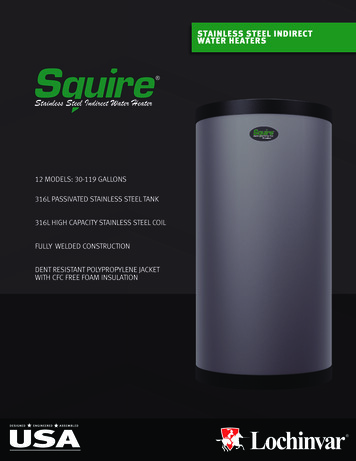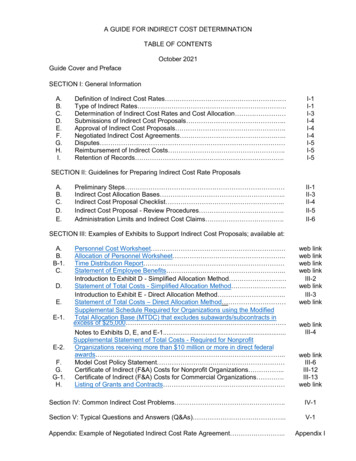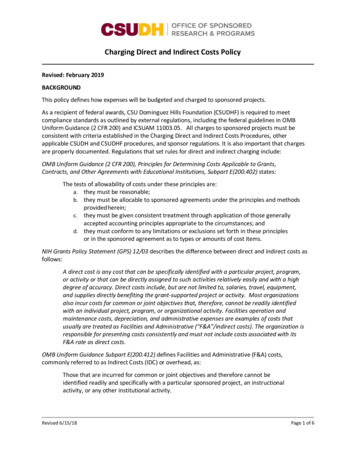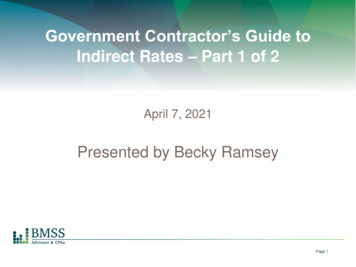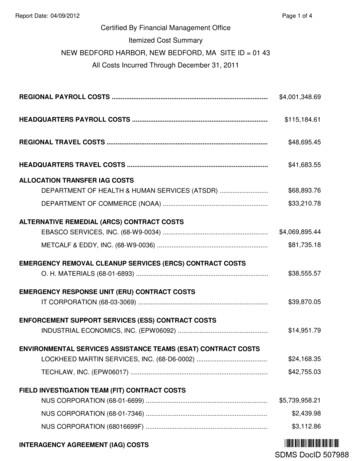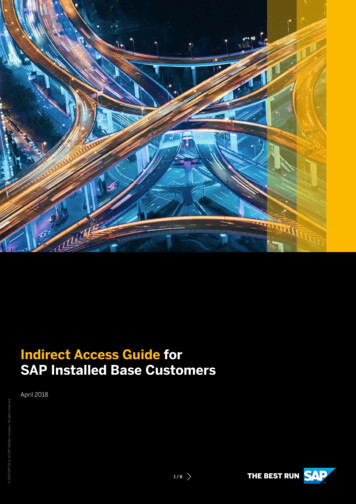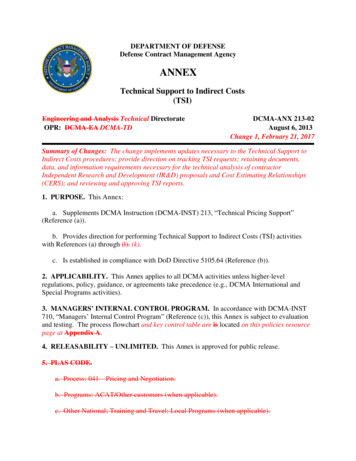
Transcription
DEPARTMENT OF DEFENSEDefense Contract Management AgencyANNEXTechnical Support to Indirect Costs(TSI)Engineering and Analysis Technical DirectorateOPR: DCMA-EA DCMA-TDDCMA-ANX 213-02August 6, 2013Change 1, February 21, 2017Summary of Changes: The change implements updates necessary to the Technical Support toIndirect Costs procedures; provide direction on tracking TSI requests; retaining documents,data, and information requirements necessary for the technical analysis of contractorIndependent Research and Development (IR&D) proposals and Cost Estimating Relationships(CERS); and reviewing and approving TSI reports.1. PURPOSE. This Annex:a. Supplements DCMA Instruction (DCMA-INST) 213, “Technical Pricing Support”(Reference (a)).b. Provides direction for performing Technical Support to Indirect Costs (TSI) activitieswith References (a) through (l). (k).c. Is established in compliance with DoD Directive 5105.64 (Reference (b)).2. APPLICABILITY. This Annex applies to all DCMA activities unless higher-levelregulations, policy, guidance, or agreements take precedence (e.g., DCMA International andSpecial Programs activities).3. MANAGERS’ INTERNAL CONTROL PROGRAM. In accordance with DCMA-INST710, “Managers’ Internal Control Program” (Reference (c)), this Annex is subject to evaluationand testing. The process flowchart and key control table are is located on this policies resourcepage at Appendix A.4. RELEASABILITY – UNLIMITED. This Annex is approved for public release.5. PLAS CODE.a. Process: 041 – Pricing and Negotiation.b. Programs: ACAT/Other customers (when applicable).c. Other National; Training and Travel; Local Programs (when applicable).
DCMA-ANX 213-02August 6, 2013Change 1, February 21, 20175. LABOR CODES. Located on resource page.6. POLICY RESOURCE WEB PAGE. https://home.dcma.mil/policy/213-02rww6. RESOURCE PAGE: https://360.dcma.mil/sites/policy/EA/SitePages/213 02R.aspx7. EFFECTIVE DATE. By order of the Director, DCMA, this Change is effective uponrelease. CMOs must be policy compliant 30 days after policy release.NOTE: The Director approved this issuance on February 21, 2017, with direction toincorporate her comments prior to release. The effective release date is June 6, 2017.2
DCMA-ANX 213-02August 6, 2013Change 1, February 21, 2017TABLE OF CONTENTSREFERENCES . 4CHAPTER 1 – OVERVIEW1.1. Overview .51.2. Protecting Classified and Controlled Unclassified Information (CUI) .51.3. Delegation of Responsibilities .6CHAPTER 2 – RESPONSIBILITIES2.1. Contract Management Office (CMO) Commander/Director .72.2. CMO Engineering and Analysis (E&A) Director/Technical Lead(Integrated Cost and Analysis Team (ICAT) Director at ICAT CMOs)CMO Engineering and Manufacturing Group Chief (EMGC) or Integrated CostAnalysis Team (ICAT) Director (at ICAT CMOs) .72.3. TSI Coordinator .72.4. Technical Specialist .82.5. Technical Supervisor or Technical Lead .8CHAPTER 3 – PROCEDURES3.1.3.2.3.3.3.4.3.5.3.6.3.7.Receive and Coordinate TSI Requests . 10Perform Documentation Check for Adequacy and Completeness . 10Conduct Technical Analysis of Indirect Costs.11Provide Technical Support to Cost Monitoring Efforts .14Prepare TSI Report .14Provide Negotiation Support.16Engineering Records Management .16APPENDIXAppendix A. TSI Process Flowchart .14GLOSSARYAcronyms .183
DCMA-ANX 213-02August 6, 2013Change 1, February 21, 2017REFERENCES(a) DCMA-INST 213, “Technical Pricing Support,” April 3, 2013 March 20, 2014(b) DoD Directive 5105.64, “Defense Contract Management Agency (DCMA),”January 10, 2013(c) DCMA-INST 710, “Manager’s Internal Control Program,” September 12, 2011April 21, 2014(d) Federal Acquisition Regulation (FAR) 31.201-2, 3, 4 “Determining Allowability,Reasonableness, Allocability”(e) DCMA-INST 130, “Forward Price Rates Agreement,” July 21, 2014(f) FAR 31.205-18 “Independent Research and Development and Bid and ProposalCosts”(g) Defense Federal Acquisition Regulation Supplement (DFARS) 231.205-18“Independent research and development and bid and proposal costs”(h) DFARS 215.404-71-5 “Cost efficiency factor”(i) FAR 31.205-17 “Idle Facilities and Idle Capacity Costs”(j) FAR 31.205-25, “Manufacturing and Production Engineering Costs”(k) DCMA-INST 123, “Cost Monitoring,” August 14, 2013 October 10, 2014, as amended(l) DCMA-INST 552, “Information Security Program,” August 15, 2014(m) FAR 3.104-4, “Disclosure, Protection and Marking of Contractor Bid or ProposalInformation and Source Selection Information”(n) DCMA Memorandum #13-202, “EDW Document Clean-up and “Old” DocumentsPurge,” July 31, 2013(o) DCMA Memorandum # 15-057, “Integrated Workload Management System (IWMS) AgencyDeployment”, March 19, 2015(p) DCMA-INST 629, “DAWIA Training Management,” March 7, 2012, as amended(q) DCMA-INST 1206, “First Level Supervisor Review,” July 24, 20144
DCMA-ANX 213-02August 6, 2013Change 1, February 21, 2017CHAPTER 1OVERVIEW1.1. OVERVIEW. This Annex serves as supplemental guidance to supplements DCMA-INST213, “Technical Pricing Support” (Reference (a)) in the area of Technical Support to IndirectCosts (TSI). The intent of TSI is to:1.1.1. Provide timely, high- and quality technical pricing support (TPS) in the area ofindirect costs to the administrative contracting officer (ACO) or cost monitoring specialist(CMS) during the analysis of forward pricing rate proposal (FPRP) and cost monitoringefforts. TSI will follow the negotiated priority set by the ACO or CMS. The Agency’s intentis to assign priority support for the three major areas of indirect costs: Business BaseIndependent Research and DevelopmentCost Estimating Relationships1.1.2. Promptly acknowledge receipt of TSI requests.1.1.3. Promptly conduct a preliminary review of the detailed TSI request to determinecompleteness with pertinent supporting data that justifies the contractor’s proposed rates.Notify coordinating the requestor, who may be the divisional administrative contractingofficer (DACO)/corporate administrative contracting officer (CACO), or administrativecontracting (ACO), cost monitoring specialist (CMS), procuring contract officer or DefenseContract Audit Agency, if the TSI package is incomplete. The assumption is that all TSIrequests will pass through the ACO, even technical-only requests from outside agencies.Technical-only requests are understood to be requests for technical support of indirect costsonly, and no additional contract management office (CMO) support is needed. (NOTE:ACO, as used in this Annex, refers to the CACO, DACO, or ACO. Also, the wordrequestor identifies the ACO and the CMS. In many cases, the request for technical analysiswill come from the CMS as delegated by the ACO. In other cases, external request from theprogram office or the Defense Contract Audit Agency will provide TSI requests.)1.1.4. Complete TSI analysis and provide a report to the requestor within thenegotiated due date in order to minimize delay to procurement actions.1.1.5. Support cost monitoring efforts, as requested.1.2. PROTECTING CLASSIFIED AND CONTROLLED UNCLASSIFIED INFORMATION(CUI). Protecting information is critical and integral when conducting the processes associatedwith this Annex. DCMA personnel are responsible for protecting classified and controlledunclassified information (CUI) entrusted to them. DCMA personnel must take prudent steps toensure final disposition of classified and CUI per DCMA and DoD policy. These procedures5
DCMA-ANX 213-02August 6, 2013Change 1, February 21, 2017vary based on the type, access, and nature of the material involved. Refer to the DCMA-INST552, “Information Security Program” (Reference (l)), for guidance in the control, transmission,destruction, and storage of such material.1.3. DELEGATION OF RESPONSIBILITIES. The individuals holding the positions listed inChapter 2 of this Annex may delegate their responsibilities unless expressly prohibited by thisAnnex, another DCMA Instruction, higher-level guidance, regulations, law, or statute. Theindividual delegated the responsibility does not have the authority to further delegate theresponsibility.6
DCMA-ANX 213-02August 6, 2013Change 1, February 21, 2017CHAPTER 2RESPONSIBILITIES2.1. CONTRACT MANAGEMENT OFFICE (CMO) COMMANDER/DIRECTOR. TheCMO commander/director shall must ensure compliance with this Annex.2.2. CMO ENGINEERING AND ANALYSIS (E&A) DIRECTOR/TECHNICAL GROUPCHIEF/TECHNICAL LEAD (INTEGRATED COST ANALYSIS TEAM (ICAT) DIRECTORAT ICAT CMOs). The CMO E&A Director/Technical Group Chief/Technical Lead (ICATDirector) shall designate a single TSI coordinator to manage all TSI requests. For CMOs withmultiple programs that do not overlap use of resources, it is acceptable to assign a coordinator foreach program.2.2. CMO ENGINEERING AND MANUFACTURING GROUP CHIEF (EMGC) ORINTEGRATED COST ANALYSIS TEAM (ICAT) DIRECTOR (at ICAT CMOs). TheCMO EMGC or ICAT Director must:2.2.1. Monitor quality and accuracy of data and products delivered.2.2.2. Manage resources (e.g., technical personnel, workload) to meet critical functionaltaskings.2.2.3. Designate a Technical Support to Indirect Costs (TSI) coordinator to manage TSIrequests.2.2.4. Maintain visibility of all technical pricing requests and trends. Establish andmaintain a process for minimizing turnaround times for technical pricing reports to include theapproach for identification and disposition of any systemic issues.2.2.5. (EMGC only) Manage workforce development of CMO engineering and technicalstaff, ensure that authors and reviewers of Technical Pricing Reports are working toward andattain Defense Acquisition Workforce Improvement Act (DAWIA) certification at the appropriatelevel in accordance with DCMA-INST 629 (Reference (p)), and the Office of the UnderSecretary of Defense for Acquisition, Technology, and Logistics Workforce Desk Guide(technical specialists providing matrix type support to the engineering organization, must havethis function performed by their supervisor of record), ICAT Directors, have additionalsupervisory responsibilities as defined in paragraphs 2.5.6. and 2.5.7.2.3. TSI COORDINATOR. The TSI coordinator shall is responsible for, and must not delegatethe following (NOTE: work performed by personnel assigned “acting” positions, or higher levelsupervision, is not considered delegation):2.3.1. Acknowledging TSI requests. using alternate methods, such as email, for documentingcases until such time that an eTool or another system of document control (safe system withbuilt-in redundancy to prevent single point of failure loss) is provided. TSI requests received7
DCMA-ANX 213-02August 6, 2013Change 1, February 21, 2017directly from sources external to DCMA, or via the technical specialist, must be routed to theACO for coordination.2.3.2. Identifying necessary functional support for the completion of the TSI request,coordinating support with appropriate supervisors/leads, and convey the support and deadlinerequirements to the technical team.2.3.3. In the event the deadline is not feasible, Recommending and negotiating a newsuspense dates with the requestor when deadlines are not feasible.2.3.4. Ensuring the appropriate supervisor/lead reviews and approves all technical reports.Approval shall must be completed prior to formal release of analysis.2.3.5. Submitting the approved report to the requestor.2.3.6. Document completion of TSI report using alternate methods, such as email, fordocumenting cases until such time that an eTool or another system of document control(safe system with built-in redundancy to prevent single point of failure loss) is provided.Log and track all TSI cases utilizing direction provided on the DCMA-INST 213,“Technical Pricing Support,” resource page.2.4. TECHNICAL SPECIALIST. The technical specialist (e.g., engineer, industrial specialist,quality assurance representative) shall must:2.4.1. Review TSI package for completeness per the written detailed request from therequestor.2.4.2. Complete analysis for the areas detailed in the TSI request. Coordinate with allfunctional areas as applicable (e.g., software, engineering, manufacturing and quality) to obtaintechnical inputs, to sufficiently respond to the request. Inputs from all technical disciplines mustbe consolidated into one comprehensive and cohesive report, ensuring consistency ofrecommendations between the technical areas, and that no conflicting information is provided inthe report.2.4.3. Maintain work papers, including electronic documents to support the analysis TSIrequests, reports, and working documents supporting the analysis in accordance with thedirection provided on the DCMA-INST 213 resource page.2.4.4 Prepare and sign a well-documented TSI report that incorporates the analysis andtechnical recommendations. Signature must be physical or electronic.2.4.5. Provide Submit the signed final report to the TSI Coordinator. At CMOs where theTSI coordinator is not the technical supervisor or technical lead, the technical specialist mustsecure technical supervisor or technical lead review, approval, and signature, prior tosubmitting the report to the TSI coordinator.8
DCMA-ANX 213-02August 6, 2013Change 1, February 21, 20172.4.6. Route all internal and external TSI requests through the TSI coordinator.2.5. TECHNICAL SUPERVISOR OR TECHNICAL LEAD. The technical supervisor ortechnical lead is responsible for, and must not delegate the following (NOTE: work performed bypersonnel assigned “acting” positions, or higher level supervision, is not considereddelegation):2.5.1. Manage resources for pricing support (for technical supervisor only).2.5.2. Manage the quality control of all technical pricing products.2.5.3. Assign technical specialists to TSI cases in coordination with the TSI coordinator.2.5.4. Review, approve, and sign (physically or electronically) the final TSI report.2.5.5. Ensure that the technical specialist maintains records of Requests for Information,contractor data, and analysis data, and ensures that the records maintained are readable,retrievable, and accessible.2.5.6. (Technical supervisor only) Ensure that all engineers and technical staff supportingtechnical pricing activities are DAWIA certified in their primary career field (Level IIminimum) within 24 months of assignment to the agency. Ensure TPS education requirements,based on assigned Learning Maps in the Talent Management System (TMS), and any otherassigned training requirements have been fulfilled, or that a satisfactory schedule for completionis in place.2.5.7. (Technical supervisor only) Ensure that DCMA-INST 1206, “First Level SupervisorReview,” (Reference (q)) and the FLSR eTool (or an approved alternate) is used to schedule,conduct, and document reviews on assigned functional specialists. Supervisors must track,plan, execute, and monitor employee development (technical specialists providing matrix typesupport to the engineering organization, must have this function performed by their supervisorof record). Specifically, but not exclusively:a. Verify that the individual has received policy specific functional training, DAWIA(category and level) certified (or on track).b. Determine competency and identify competency gaps based on assigned LearningMaps in the TMS, and any other assigned training requirements.9
DCMA-ANX 213-02August 6, 2013Change 1, February 21, 2017CHAPTER 3PROCEDURES3.1. RECEIVE AND COORDINATE TSI REQUESTS. TSI requests should be received usingalternate methods, such as email, for documenting cases until such time that an eTool or anothersystem of document control (safe system with built-in redundancy to prevent single point offailure loss) is provided. The TSI coordinator shall must promptly acknowledge requests. TheTSI coordinator must track all TSI cases utilizing the direction provided on the DCMA-INST213, resource page, see paragraph 2.3.6. of this Annex, and acknowledge and close all requestsfor technical support via written correspondence. The request should be detailed and preciselyidentify what aspects of the FPRP, or other areas of indirect costs, need to be evaluated. All TSIrequests must be coordinated through the TSI coordinator. Process flowcharts and key controltables are posted on the resource page of this Annex.3.1.1. The scope of the request shall must l be reviewed by the TSI coordinator. The TSIcoordinator shall must identify all functional areas necessary to complete the analysis andcoordinate support with the appropriate leads/supervisors.3.1.2. The TSI coordinator shall must clearly specify the due date necessary toaccommodate the technical evaluation and a supervisory/lead review and approval of the finalreport within the overall schedule.3.1.3. If resources are not available or unable to support the requested timeline, theACO or CMS will set the priority and an adjusted completion date will be negotiatedbetween the TSI coordinator and the requestor.3.2. PERFORM DOCUMENTATION CHECK FOR ADEQUACY ANDCOMPLETENESS.3.2.1. The TSI package shall must include the analysis request, a copy of the FPRP orspecial review documentation as part of a cost monitoring effort, and supportingdocumentation compiled and reviewed by the requestor. If pertinent documentation is missing,the technical specialist should request them from the requestor. The analysis request generallyincludes, but is not limited to: Requestor proposal review approachReview team membersAnalysis requirements and due datesOther pertinent information related to conducting the review3.2.2. The technical specialist shall must perform a review of the contractor dataprovided to support the rationale and estimates within the TSI request to determineallowability, reasonableness, and allocability per Federal Acquisition Regulation (FAR)31.201-2, 3, 4 (Reference (d)). This review should allow for adequate time to request10
DCMA-ANX 213-02August 6, 2013Change 1, February 21, 2017additional details from the contractor. Per local guidance, the technical specialist mayrequest needed data during a fact-finding session with the contractor or via the locallyapproved process for requesting information, provided one exists.3.2.2.1. When request for information RFIs and exchanges with the contractor areconducted, they should be coordinated with the requestor. Other evaluation team membersshould be invited, as appropriate. Following the meeting, ensure that any pertinentinformation provided by the contractor is documented in a memorandum of record orsimilar means. The resulting data/understanding should also be sent to the contractorrepresentative to make sure there are no disagreements relative to what information wasprovided and/or to document what additional information needs to be provided.3.2.2.2. When requesting information, local guidance should dictate the appropriatemethod/format, if applicable. Information exchanges and meeting minutes/action itemsshall must l be documented and provided to the requestor and copied to the contractor fortheir awareness and to include in the permanent file.3.2.3. A walk-through should be conducted for each contractor FPRP review. Thisreview should be coordinated by the requestor and all proposal review team members.Refer to DCMA-INST 130, “Forward Price Rate Agreements” (Reference (e)), foradditional information. The walk-through is a valuable method for gaining the necessaryunderstanding of the contractor’s data. Efficient use of time and resources in necessary toensure deadlines are met and engineering solutions provided.3.3. CONDUCT TECHNICAL ANALYSIS OF INDIRECT COSTS.3.3.1. The objective of technical analysis of the indirect costs is to provide sufficientinformation and insight into a contractor’s proposed costs to assist the ACO to negotiate fairand reasonable rates, and for the execution of a timely forward price rate agreement and for thedevelopment of recommended rates.3.3.2. The technical analysis of an FPRP shall must be consistent with the detailed request.All requested areas shall must be addressed in the analysis and subsequent report. Analysis andrecommendations should be based on facts and quantitative data. The technical analysis willassess a wide range of costs, cost factors, and other associated information in support of an FPRPevaluation. Areas of review may be the contractor’s business base, independent research anddevelopment (IR&D) efforts, cost estimating relationships (CER), cost estimating systems orbusiness systems (dependent upon contractual obligations), depreciation (capital equipment andfacilities), proposed contractor cost reduction initiatives, and other areas identified by therequestor. These analyses and reviews span a number of cost considerations and cost elementsand may include analysis of labor hours and labor categories provided within the allocation basesused to develop certain rates proposed within the FPRP, scrutinizing costs associated withproposed capital purchases and upgrades, assessing information technology (IT) requirementsand costs, analyzing facility capacities for reasonableness and possible excess, and evaluating thecontractor’s estimates of current and future workloads.11
DCMA-ANX 213-02August 6, 2013Change 1, February 21, 20173.3.3. Technical Analysis of Business Base. Evaluate project schedules and the directcosts associated with those schedules to determine the reasonableness of the business baseproposed, and review the scope of work included in the business base for applicability to therelated cost pool. Determine if the business base accurately reflects the projected costs for theforecasted level of direct work proposed for each of the projects included under the base, asmeasured in labor dollars, labor hours, materials, or other direct costs by program by year.The business base forecast contains each of the allocation bases used for all of the indirectrates found in the contractor’s FPRP.3.3.4. Technical Analysis of Independent Research and Development and Bid andProposal (IR&D/B&P). Determine that IR&D costs proposed are of potential interest to DoD,allowable as set forth in the FAR 31.205-18 and Defense Federal Acquisition RegulationSupplement (DFARS) 231.205-18 (References (f) and (g)) and not allocable to another costcategory. B&P costs may also be considered in the overall allowability analysis as identifiedin DFARS 231.205-18 (Reference (g)).3.3.4.1. For contractors with a large number of IR&D projects, consider a sample ofIR&D projects to be selected based on the dollar value of the projects, and the level of cost riskthe projects present to the Government. Specific projects may also be selected as part of thereview by the requestor.3.3.4.2. Review the project scope to ensure proper classification of the effort asqualifying IR&D. Ensure the project effort does not include required tasks already beingcompleted for another contract.3.3.4.3. Cost reasonableness of forecast IR&D costs can be evaluated based on: Forecast business volumeNature and size of the programs that the contractor has included in its projectedsales baseRelevance of the proposed IR&D costs to projected Government programsLikelihood of those programs continuing at the levels forecast3.3.4.4. Refer to the Guidance section of this Annex’s resource page for a listing ofcontractor IR&D data and information that may be requested in addition to the data andinformation received in the original request package (reference paragraph 3.2.1.), to enable thetechnical review.3.3.5. Technical Analysis of Cost Estimating Relationships (CER). The objective ofperforming technical analysis on a CER is to ensure that the CER is valid and appropriate forthe cost the CER is being used to estimate.3.3.5.1. Determine if the CER demonstrates:12
DCMA-ANX 213-02August 6, 2013Change 1, February 21, 2017 Logical relationship between the cost being estimated and the independentvariableData being used is verifiableCER projects costs with reasonable degree of accuracy3.3.6. Evaluating Contractor’s Cost Estimating System (CES). The objective of performinga technical analysis of a contractor’s CES is to determine a contractor’s ability to consistentlyproduce well supported proposals that are acceptable as a basis for the negotiation of fair andreasonable prices. Using an acceptable estimating system is a key to consistently preparingquality estimates which are both accurate and reliable. The Government and contractor bothbenefit from a contractor having an acceptable estimating system.3.3.6.1. The technical specialist’s main task is to report any contractor estimating issuesfound during the normal course of business or while participating in a formal cost estimatingsystem review. This should be accomplished by using the following techniques with respect tothe technical evaluation of labor, material, and other direct costs:3.3.6.1.1. Review and determine if the contractor’s cost estimating policies andprocedures are reasonable and sound.3.3.6.1.2. Compare past estimates with actual data to determine the accuracy of thecontractor’s estimating methods.3.3.6.1.3. Review proposals and basis of estimate to determine if the contractor isconsistently applying estimating methods and techniques.3.3.7. Technical Analysis of Proposed Contractor Cost Reduction Initiative. This analysisis to determine if the contractor’s cost reduction initiatives are appropriate to meet the criteriaidentified in DFARS 215.404-71-5 (Reference (h)) and to assess whether a contractor’sestimate of the cost saving projections from the future implementation are reasonable. Duringthe cost monitoring process (see paragraph 3.4 of this document), the technical specialist shallmust determine if, after a cost reduction initiative has been implemented, the savings havebeen achieved. As part of an FPRP evaluation, the technical specialist will evaluate thecontractor’s cost reduction initiative justification to analyze its baseline for accuracy andprovide technical recommendation of acceptableness.3.3.8. Technical Analysis of Facility Costs. A technical analysis or evaluation of facilitycosts may include idle facilities, idle capacity, plant rearrangement, rental costs, depreciation(capital equipment and facilities), information technologies, and any other requests for atechnical analysis of indirect costs from the requestor. When specific facilities or equipmentare not identified by the ACO, statistical sampling techniques may be used to validate status.Document the methodology of analysis in the TSI report.3.3.8.1. Indirect costs related to idle facilities and idle capacity can be found in FAR31.205-17 (Reference (i)). The technical specialist shall must identify the status and use of the13
DCMA-ANX 213-02August 6, 2013Change 1, February 21, 2017facilities identified by the requestor.3.3.8.2. Plant rearrangement costs are discussed in FAR 31.205-25 (Reference (j)).The technical specialist shall must review the proposed and/or verify the existing change is asdescribed by the contractor.3.3.8.3. A technical evaluation of a contractor’s asset depreciation (capital equipmentand facilities) shall must be conducted to ensure the depreciated tangible and intangible assets arecredible and relevant. Asset inventory lists should be checked to validate the status of the assetand to ensure that asset retirements have been properly accounted. The technical specialist shallmust review milestone schedules and project progress. When depreciation expense is tied to aparticular project, evaluate the project’s status and the percentage of work completed on theproject. A capital improvement plan asset or capital work in progress asset which is notcompleted may not be depreciated until the asset is placed in service.3.3.8.4. IT shall must be reviewed to determine reasonableness for DoD usage. Areasto focus are: Need for proposed projectsPurchasesLevel of current IT needs3.4. PROVIDE TECHNICAL SUPPORT TO COST MONITORING EFFORTS. Thetechnical specialist serves as a key member of the cost monitoring team (CMT). The technicalspecialist’s primarily reviews and evaluates any areas identified by the CMS where technicalexpertise is required to determine the effectiveness, necessity, or efficiency of the contractor’soperations. To be an effective member of the CMT, the technical specialist shall must workwith the CMS to understand what is required of them during the cost monitoring effort and toestablish a comprehensive understanding of the contractor’s organizational structure, historyof sales, system of budgeting, collecting, and assigning costs. Where time and
Contract Audit Agency, if the TSI package is incomplete. The assumption is that all TSI requests will pass through the ACO, even technical-only requests from outside agencies. Technical-only requests are understood to be requests for technical support of indirect costs only, and no additional contract management office (CMO) support is needed .
